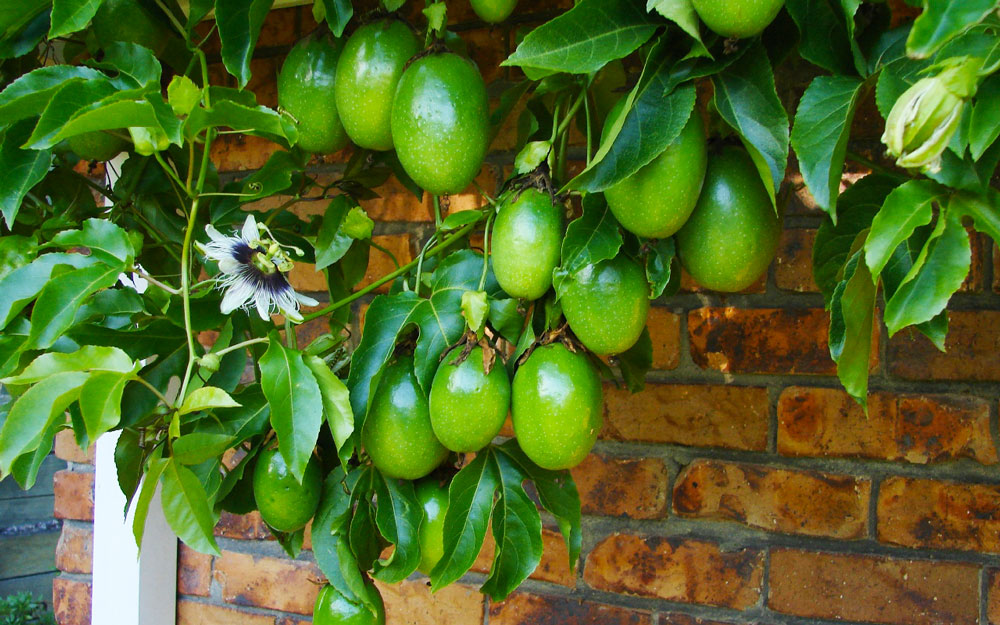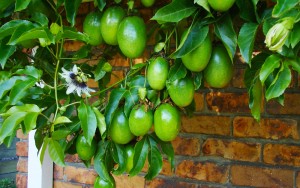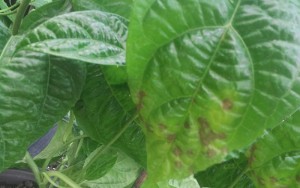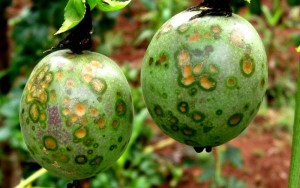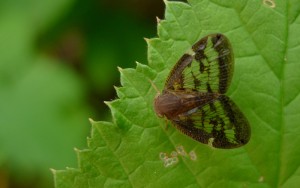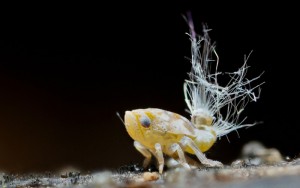Read our top tips for growing delicious and healthy passionfruit.
Healthy plants grown in healthy soil in the right place are far less likely to suffer from the fungal and bacterial spots that passionfruit can be susceptible to. Getting things right initially when siting and planting can make growing them considerably easier, especially if you care for them correctly as they grow.
Planting Passionfruit
Position
Full sun. They prefer to be planted in fertile, free-draining soil rich in organic matter in a spot with a reasonable amount of airflow.
As they are a vine you will need to choose a spot where you can either make a structure or take advantage of an existing one for them to climb along.
If you are planting multiple plants, leave at least 3m between each plant.
Planting
Dig a hole at least twice as wide and deep as the pot the plant came in. Backfill, leaving enough space to plant your passionfruit with a mix of your top soil, compost and sheep pellets. Water-in well after planting.
In heavier soils it is often worth making a larger hole and planting into a slight mound to ensure the soil won’t be too wet over the wetter months. Adding gypsum will also help improve the soil structure.
Caring for Passionfruit
Watering
Keep plants well watered through the drier months. Deeply watering 2-3 times a week is more effective than a slight sprinkle every day.
When watering avoid wetting the foliage, and if possible, water in the morning. Water the soil near the plant, not the plant itself. Fungal problems thrive in damp, humid conditions, and plants are more susceptible if they are water stressed. So watering regularly and how you water are really important.
Training and Pruning
By encouraging your passionfruit to stay fairly open you increase the airflow around the plant (which reduces humidity and the likelihood of diseases). Do this by pinching or cutting out denser growth.
The fruit itself is formed on this season’s wood. So to improve fruiting prune in early spring and, in general, it’s worth pruning one lateral hard each year.
To stop your passionfruit vine from getting too big, pinch out the tips when it gets to the size you want.
Feeding
Feeding with many natural fertilisers is a great way to give the plant the nutrients it needs whilst improving the health and fertility of the soil. Healthy soil is a complex ecosystem full of minerals, the weathered, small remains of rock, organic matter, beneficial microbes, air and water. Healthy soil will hold more moisture and nutrients, making problems less likely even if your plants don’t get watered or fed quite enough.
To feed and improve the soil, sprinkle a few handfuls of sheep pellets around the roots in spring and feed monthly with Aquaticus Organic Garden Booster.
What to do if problems arise?
While good practise reduces the chance of problems, it sadly doesn’t eliminate them. The main issues that arise are spotting of the leaves or fruit, or insect problems, especially the aptly named Passionvine Hopper.
The spots on the leaves can be caused by both fungal and bacterial diseases, but in most cases the treatment is the same. In mild cases remove infected leaves and fruit and dispose of them away from the fruit. It’s also worth clearing away any leaves that have fallen from the vine from the ground. In worse cases applying copper can help.
For more advice on passionfruit spots click here
Passionvine Hoppers are small, slightly moth-like, brown insects with partially transparent wings. The juvenile nymphs are wingless and commonly known as ‘fluffy bums’ due to their fluffy tails. They will harm a wide array of plants, including passionfruit. They harm the plants by sucking the sap, which can reduce the vigour of plants and help transmit diseases. In most cases they can be successfully dealt with by using Aquaticus Bugtrol.
Left: Adult Passionvine Hopper Right: Juvenile Passionvine Hopper
For more advice on dealing with Passionvine Hoppers click here

